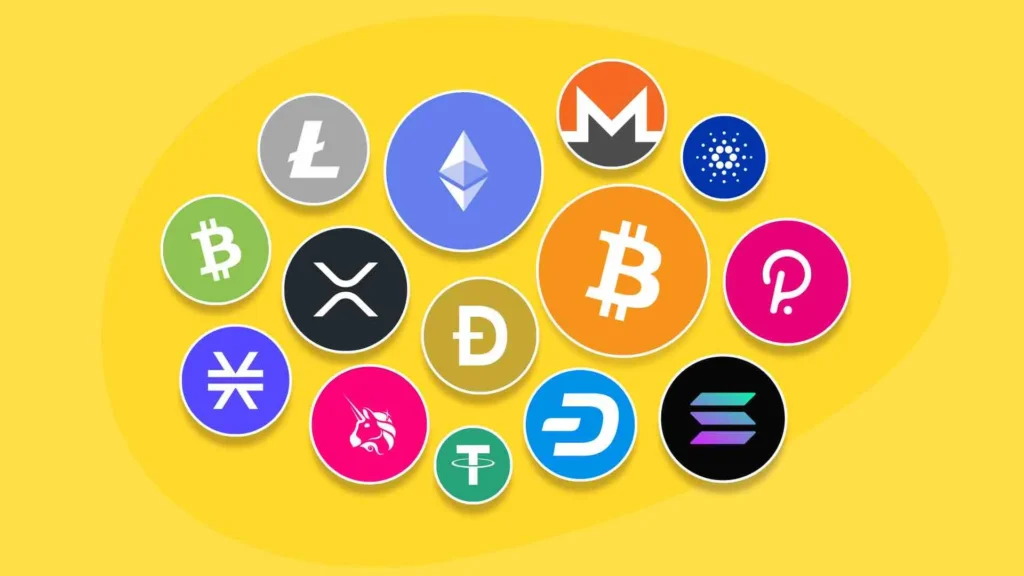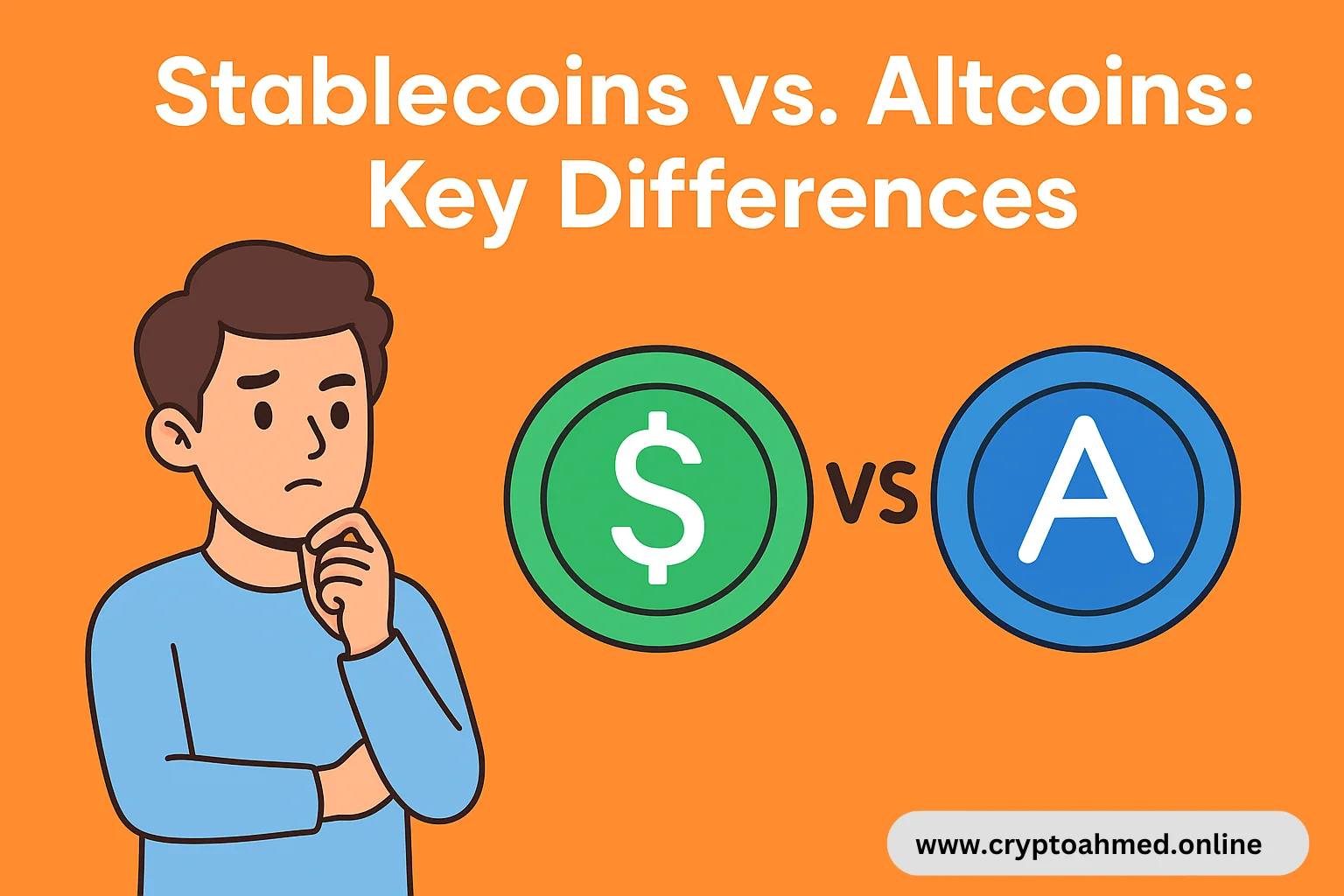The cryptocurrency market is filled with thousands of digital coins and tokens, each serving a unique purpose. For anyone stepping into the crypto space, two terms you’ll hear a lot are stablecoins and altcoins. While both fall under the cryptocurrency umbrella, they’re designed for very different goals.
Stablecoins are all about stability — they aim to maintain a consistent value, often pegged to fiat currencies like the US dollar. Altcoins, on the other hand, are the experimental and innovative side of crypto, offering a wide range of features, technologies, and investment opportunities beyond Bitcoin.
Understanding the difference between these two types of coins is essential if you’re planning to invest, trade, or simply navigate the fast-moving world of digital assets. Let’s break it down clearly and see what makes stablecoins and altcoins so different — and how both fit into the bigger crypto ecosystem.
What Are Stablecoins?

Stablecoins are cryptocurrencies created to maintain a steady price, typically pegged to a stable asset like the US dollar, euro, or even gold. This pegging helps eliminate the massive price swings that make cryptocurrencies like Bitcoin or Ethereum risky for everyday transactions.
The main idea behind stablecoins is price stability. In a market known for its volatility, stablecoins offer a reliable medium of exchange and store of value. For example, if you hold Bitcoin and its price drops 10% overnight, your investment loses value immediately. But if you convert that Bitcoin into a stablecoin like USDT (Tether) or USDC (USD Coin), your funds remain stable around $1 per coin.
Types of Stablecoins
There are three major types of stablecoins, categorized based on how they maintain their peg:
1. Fiat-Collateralized Stablecoins
These are backed by real-world assets such as US dollars held in bank reserves.
Examples: USDT (Tether), USDC, BUSD
- For every 1 USDC in circulation, there’s roughly 1 USD held in reserve.
- The stability depends on the trust and transparency of the issuing company.
2. Crypto-Collateralized Stablecoins
These are backed by other cryptocurrencies like Ethereum or Bitcoin.
Example: DAI by MakerDAO
- They use smart contracts to lock crypto as collateral and maintain the $1 peg.
- Since crypto prices fluctuate, these stablecoins are often over-collateralized to stay secure.
3. Algorithmic Stablecoins
These aren’t backed by any physical or crypto asset. Instead, they use algorithms to control supply and demand.
Example: TerraUSD (before its collapse)
- The algorithm increases or decreases the number of coins in circulation to maintain the price.
- However, this model carries higher risk, as seen in the 2022 Terra crash.
Why Are Stablecoins Important?
Stablecoins play a vital role in the crypto economy. Here’s why they matter:
1. Reduce Volatility: Traders can quickly move funds between exchanges or assets without worrying about price swings.
2. Easy Transfers: They enable fast and low-cost global payments without relying on banks.
3. DeFi Integration: Stablecoins are the backbone of decentralized finance (DeFi) — used for lending, borrowing, and earning interest.
4. Safe Haven: During market downturns, investors often convert volatile assets into stablecoins to protect their capital.
In simple terms, stablecoins act as the bridge between traditional finance and digital assets. They combine the best of both worlds — the efficiency of blockchain with the stability of fiat currency.
What Are Altcoins?

Altcoins, short for “alternative coins,” refer to every cryptocurrency other than Bitcoin. When Bitcoin launched in 2009, it was the only crypto that existed. As blockchain technology evolved, new projects began creating their own coins to improve on Bitcoin’s limitations or explore new possibilities.
Today, there are thousands of altcoins, each serving a unique purpose. Some power smart contracts, others improve transaction speed or offer privacy, and a few are created just for fun — like meme coins.
Altcoins bring innovation to the crypto world by expanding what blockchain can do beyond simple payments.
Types of Altcoins
Altcoins come in many forms.
1. Utility Tokens
Used within a specific ecosystem for transactions or services.
Example: BNB (Binance Coin), used for trading fee discounts on Binance.
2. Smart Contract Platforms
These allow developers to build decentralized apps (dApps) and run automated contracts.
Examples: Ethereum (ETH), Solana (SOL), Cardano (ADA), Avalanche (AVAX).
3. Governance Tokens
These give holders voting rights in decentralized projects.
Example: UNI (Uniswap), COMP (Compound).
4. Meme Coins
Created mostly for fun but supported by strong communities.
Examples: Dogecoin (DOGE), Shiba Inu (SHIB).
5. Privacy Coins
Focused on anonymity and secure transactions.
Examples: Monero (XMR), Zcash (ZEC).
Altcoins can be powerful tools for growth and innovation, but they’re also highly speculative and risky. Many projects fail or lose value over time, so investors must research before diving in.
Key Differences Between Stablecoins and Altcoins
| Feature | Stablecoins | Altcoins |
|---|---|---|
| Definition | Cryptos pegged to stable assets like USD | All cryptos other than Bitcoin |
| Price Stability | Designed to stay around $1 | Highly volatile |
| Purpose | Reduce risk, store value | Innovation, investment, network utility |
| Risk Level | Low | High |
| Examples | USDT, USDC, DAI | ETH, BNB, ADA, DOGE |
| Use Cases | Payments, DeFi, trading pairs | Smart contracts, governance, staking |
| Ideal For | Stability and liquidity | Growth and experimentation |
In short, stablecoins provide the safety net, while altcoins offer the thrill of potential profits and technological breakthroughs.
Which One Should You Invest In?
Your choice depends entirely on your goals and risk tolerance.
If you want stability, steady returns, or a way to move funds without price swings, stablecoins are your best bet. They’re great for traders who want to park funds between trades or for users participating in DeFi platforms that pay interest on stablecoin deposits.
If you’re looking for growth opportunities, higher rewards, or you believe in a project’s technology, altcoins are where you’ll find that potential. However, remember that the higher the reward, the higher the risk. Altcoins can double in value in weeks — but they can also crash just as fast.
Most experienced investors use a balanced approach:
- Keep a portion of their portfolio in stablecoins for safety and liquidity.
- Allocate another part to altcoins for growth and innovation.
This mix helps manage risk while still taking advantage of the crypto market’s upside.
The Relationship Between the Two
Stablecoins and altcoins aren’t rivals — they actually work together. Stablecoins provide stability and liquidity, allowing traders to enter and exit altcoin positions easily. For example, when you sell an altcoin, you often convert it into USDT instead of fiat currency, making transactions faster and cheaper.
In DeFi, both types of coins are essential. Stablecoins provide a stable foundation for lending and borrowing, while altcoins drive innovation and expand what’s possible on the blockchain.
You Might Like This
- 5 Anti-Bitcoin Altcoins That Stay Strong When BTC Dumps
- How to Create Accurate Crypto Signals for Any Altcoin
- Top AI-Powered Altcoins Changing the Future of Blockchain Technology
- Path of Alt-Season Explained: Why Altcoins Are the Next Big Crypto Opportunity
Conclusion
Stablecoins and altcoins represent two sides of the same coin in the world of cryptocurrency. Stablecoins bring trust, consistency, and financial stability, acting as the digital version of traditional money. Altcoins bring creativity, growth, and technological advancement, pushing the boundaries of what crypto can achieve.
If you’re building a long-term crypto strategy, understanding both is crucial. Stablecoins protect your portfolio during market volatility, while altcoins open the door to innovation and profit. Together, they create a balanced, functional, and evolving digital economy.

